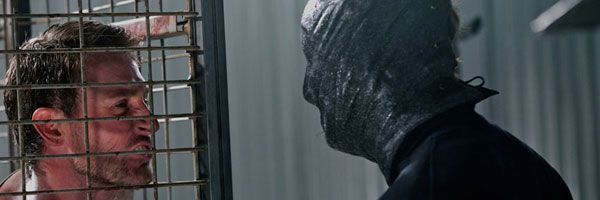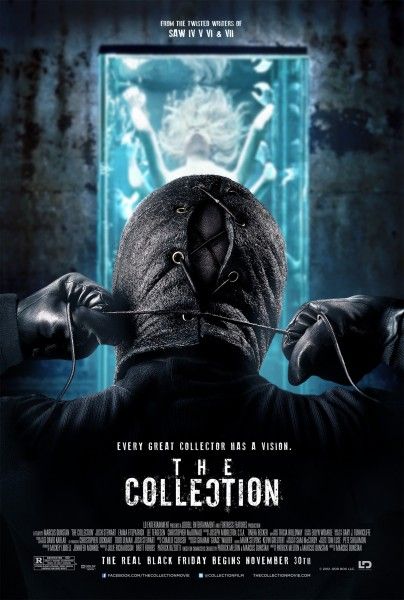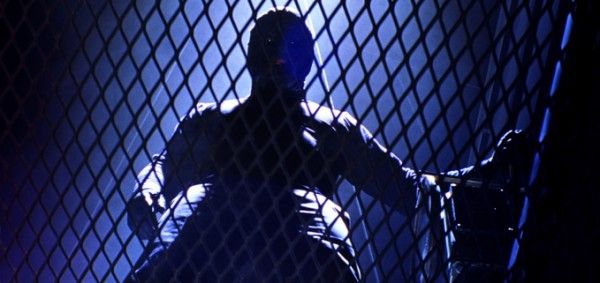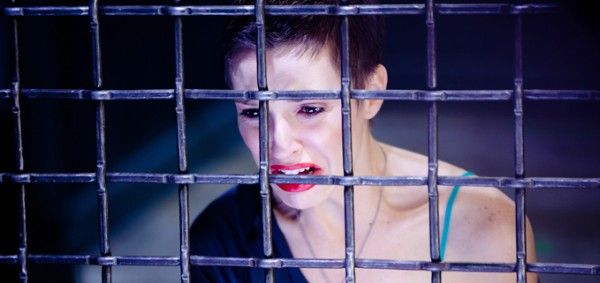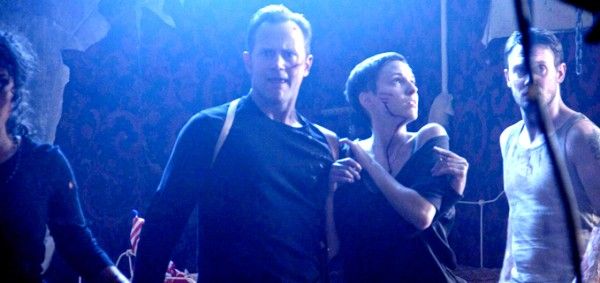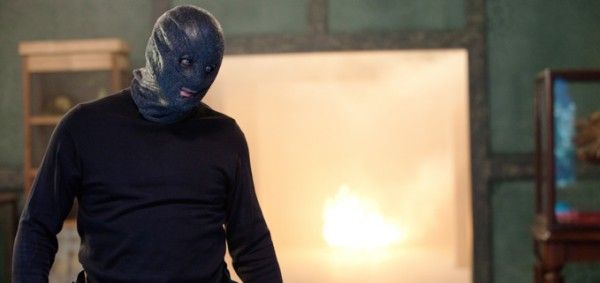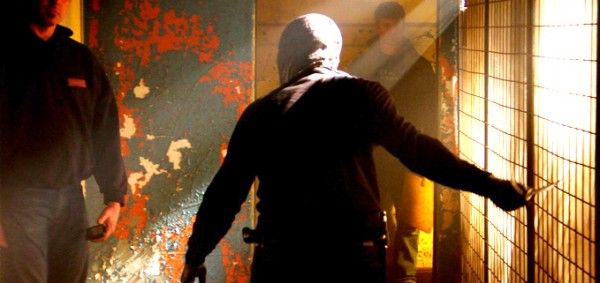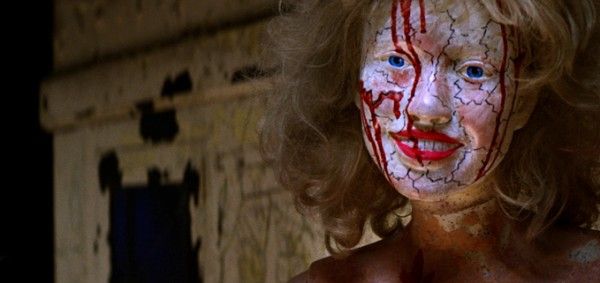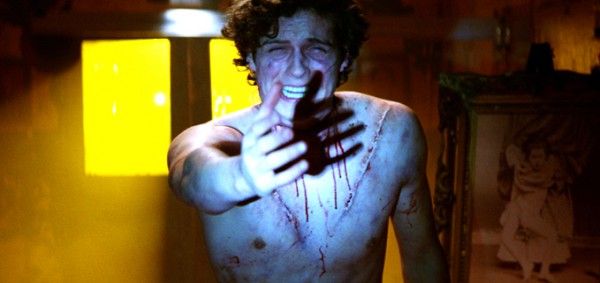Opening this weekend is The Collection. The film is a sequel to 2009's The Collector and centers on returning survivor Arkin (Josh Stewart), who is coerced into helping a team of mercenaries rescue a young woman, Elena (Emma Fitzpatrick), after she is captured by The Collector. The first movie was a lean, ruthless horror-thriller; this time around the characters are thrust into a brutal action-horror with a broader scale, bigger guns, and buckets of blood.
At the L.A. Press day, I sat down with writer/director Marcus Dunstan and writer Patrick Melton. We talked about how the sequel makes a complete 180 from its predecessor, why 35mm was their medium of choice, their approach to the action-horror sub-genre, bringing back Josh Stewart as Arkin, why they opted for practical effects, and more. Check out a transcript of the full interview after the jump.
So, The Collection was a lot fun, and it's a very interesting follow up to the first movie.
MARCUS DUNSTAN: Thank you. Well, yeah we wanted to make a middle finger to that first movie. Like, no, we're not going to do that expected sequel that should just be repeat and less. Like the diminishing return. We literally made this, wrote it, concocted it and fought to the end. So it may be the last thing we ever do. And it had to exist that this was the last time we see these characters it and end on that note of bloody satisfaction that you could walk away and be adrenalized. When the first movie came out, personally the note of despair seemed to be the best way to go, where it was like, the world is dark and you really can’t count on saving the day.
PATRICK MELTON: But we had some real dark- we had some darker endings.
DUNSTAN: Oh, it was much darker
MELTON: The original ending for the first movie was Arkin gets away with the little girl, holding her, he gets hit and he is saved. And then we go to the hospital where he is being taken care of and held down and then they think that he’s the one responsible and he's hand cuffed down, he's like “no, no” and then because the attention's on him, over everyone's shoulder you see the person who we know is the collector pick up the little girl and carry her out, and he's like, “Noooo, he only takes one.” And everybody was like, “It's a little too dark.”
DUNSTAN: It was a little dark. And now in the years since then, Pat's now a father of three.
MELTON: But I think it's OK, completely. But you know half the audience in the first movie either dug the sort of bummer ending, or they we're hurt. I think we tested once and someone said, “You left me with no hope.”
DUNSTAN: “You left me with no hope.”
[Laughs] No.
DUNSTAN: And that, to take that seriously, like a lot of time's you'd be like “high five” but no, that actually resonated in the sense that, well, we don’t want to do that again. Can we achieve the same sort of ending that the horror movies is asking for, but give it a complete 180 in stimulus.
Yeah, the movie was a definitely a drastic change from the first one, so you guys specifically set out to turn the first movie on its head?
DUNSTAN: Yes, absolutely, because we we're given the toys and it would have been a waste of the opportunity to do anything less than punch above our weight. We had the entire crew from The Walking Dead in between season 1 and 2 in Atlanta headed by Tom Luse, the line producer on the show and also the producer on our ride. Just every day we were doing more than we really were supposed to. For example there was a school in the film One Missed Call I think?
MELTON: Yeah.
DUNSTAN: That had an explosion at the end. The explosion was rigged over six weeks by a gentleman named David Fletcher
MELTON: He's an Australian.
DUNSTAN: [Does an Australian accent] Oh, he’s awesome he does Vampire Diaries and what not. So our little script comes across his desk and he's like, “Man, this is the rated R stuff, this isn’t the TV stuff. You've got to blow up a school. Hey, Tom, can I have six weeks to do it?” “You've got two!” Sure enough he was like, “Well, if we do it at this building I can do it in two.” Because he had done it before. So we did it, we rigged it in two weeks and it was twice as big. And all we did, we did a few little end camera tricks to make it seem like the entire building goes kaboom, but really it was one quadrant and then all I did was flip the image so it looked like both quadrants. And it was fun. So it took everybody in every department thinking slight-of-hand magic to make things just double, triple, quadruple in size. And really the biggest victory of all was shooting on doggone 35mm anamorphic film.
MELTON: All the flares-
DUNSTAN: Were real; beautiful! Not put in during post production.
MELTON: No, not at all.
DUNSTAN: But, very beautiful. Also, when you have practical effects anamorphic lens is going to make an actor in close up look better than any other type of lens. The digital medium is perfect, but sometimes it’s too perfect. When I can see a brush stroke of someone’s foundation, that’s taking me out. That anamorphic look that nice kind of bowed lens, wow. And then with Gary Tunnicliffe's effects, with Fletcher's kaboom, with Graham Grace Walker's amazing set design. Everything was coming together with the same alchemy of that the movies that inspired this were put together. This is supposed to be the Die Hard-ish sequel to Argento's Inferno. And that’s what we wanted, the bold colors, horror can be beautiful and were still going to keep the horror rules however were going to take some action movie character, trick them into a horror movie and then let those rules take over, and that was fun.
MELTON: The truth is there aren’t that many action-horror movies and so that was something we tried to do. This may not be apparent, and not so much with the Saw movies, but like with other things like the Feast movies, we always try to blend the genres a little bit, sometimes with varying success. And so with this one we wanted to have the horror movie characters and add action elements to it and sort of bring them together. Because you know, this sequel could have been new location, all new characters, supervillian, everyone dies. It could have been that it could have been fine, right? That was definitely discussed at some point with the financiers, but you know we kind of liked Arkin from the first movie.
DUNSTAN: We had so much investment in him. He had such a wonderful arc, and it was a beautiful performance from Josh Stewart.
MELTON: Yeah, he's a good actor.
I think it was a very good idea to bring him back, it helps bridge the two movies since they are so different.
DUNSTAN: Yes! And also not bring him back in the cheap way. Not bring him back so we can splatter his face all over the trailers and then waste him in the first scene. Because when we care about a character like we cared about him, we don’t want to see him die. It’s like where did the guys brain go between movie one and two, no this is still a vital soul, he’s the only one- he knows more than anyone else, if anything, on how to survive. So that’s what was so, I mean, it was integral to bring back the soul. And what Patrick did, which was so beautiful, was he had another complete arc as if that first movie didn’t have to exist, because far too often the rule of the sequel is let's give them more middle, just middle. And everyone walks out the same wondering inside, why does this feel like it’s not going anywhere? Because it really isn’t. It really is this sustained thing. But this one no, this is a broken man who’s terrified who does not want to face the boogie-man again, but now you got to. What are you going to do now? Is it going to break you, or are you going to use those pieces and turn them into a weapon? Oh, here’s another woman, she's just like you, she's beaten, she's down a sense, and you’re down a limb. Can you guys come together this time and maybe take down a bully? Maybe, maybe not. What if the room's on fire? Yay!
MELTON: Always add fire to complicate any situation.
Elena was really fantastic, the character and the actress.
DUNSTAN: Yeah, right?
She’s one of the better horror heroines I've seen for a while. Talk a little about creating that character.
MELTON: Well, OK, we were having a really hard time finding someone. Like a really hard time. And then coincidentally we went into a weekend and everyone happened to go see The Social Network, and all separate, three of us separate. We wanted someone with short hair, we were like, “who was that girl that looks like Natalie Portman but has the short hair?” And Joseph Middleton who is the casting guy found Emma and brought her in, she read and she was just really good; and it was like OK that’s it. And she's kind of a tough gal, if you've met her in real life. I mean, she can drink like a sailor and curses like one as well. So she definitely was perfect for the role.
DUNSTAN: She also has these pair of brass knuckles that look like a nice ring, but that's some Ohio-tough right there. The thing was in the audition process we were not looking to put someone in the same stained, sweat covered white tank-top.
MELTON: That was for Josh.
DUNSTAN: No white tank-top girl. This had to be a different person, this had to be someone who was our sister, our girlfriend, our best friend or whatnot, but in a realistic way. Not in the movie where they're all charming and, “I won't do the pot,” no this is someone that will do it all, but just can we get behind her in the situation. But the best thing was, Emma was the person who conveyed a sense that she could save herself, she didn’t have to wait around for dudes. She was going to bust out of there.
You guys mentioned that you used practical effects, which I am huge fan of, they just look so much better on film-
DUNSTAN: Yes!
Why did you choose to use practical over digital and was it an important decision to you?
DUNSTAN: It's replicating the illusions that worked on us. That’s it. This wheel was never broken. In some cases CGI is a false crutch, it just adds to the unreality of things. Where there’s something about- why could we believe E.T., who wasn’t as mobile, and felt so real to anybody? Yet when you see a completely computer generated entity, no matter how real it does seem, it just blocks you at that crucial point. The first Jurassic Park, boy did those dinosaurs feel real, and that was probably the best alchemy of all, was the blend. Real torso, a little CG and motion blur there, in fifty shots only; wonderful. So with us, OK, if we needed a wire or something, we erased all the safety elements that kept our crew and our actors OK and left all the savagery to feel real. And all of it was blended by these performances where they were like, “hey, we might be in a drama, we might be in a comedy, we might be in an action film, or a horror film, but we're going to play it true every step of the way.” That’s what allows those effects that translate and leap out and grab you. So it’s a tribute to Gary Tunnecliffe, Mike Regan, and Adreinne Lynn that these effects were so on the spot, on the day perfect, and all our cameras had to do was keep up.
MELTON: And film and practical effects work hand in hand. We’ve seen a lot of practical effects with digital and it just looks terrible because the digital is just too precise and clear. So it was really not a question on what we wanted. And it goes back to what we grew up with. The best werewolf I’ve seen is An American Werewolf in London. That was thirty years ago. You see the new movies that come out that have werewolves in them and it looks like a cartoon, and not even a good cartoon. A younger generation doesn’t get turned off by that if you grew up with it, I've kind of learned, but anyone of our age or over, or even younger who have a knowledge of film it just distances them. It reminds you that, nope, this isn’t real. So in a movie where we didn’t need to have CGI, we felt no reason to do it. Especially with the blood; digital blood, it just doesn’t work.
DUNSTAN: You can recognize the elements from other movies.
MELTON: It doesn’t have the same gravity, it just doesn’t, so why bother? That first day of shooting the rave massacre, we ran out of blood.
DUNSTAN: Fifty-five gallons.
That looked like it was fun to shoot.
DUNSTAN: It was, it was. The nice thing was after that night, we all went to the bar, the mid-town W, covered from head to toe in red stuff. We had some of the waitresses from The W showed up to be in that rave scene and they lined up the drinks after, we all high-fived and said, “thank you.”
MELTON: People were like, “Oh my god, what happened to these people.”
DUNSTAN: We were in the same hotel as The Change-Up, it was filming at the same time. And, you know, their crew they’re nine to five. They've got forty-million dollars to tell a story about two dudes in an apartment. Great, we've got ten to depict war. You're like what did you survive today?
Do you have a favorite gag?
MELTON: The rave. The rave scene was pretty much, that was it.
DUNSTAN: Well someone nailed it. It’s like the James Bond opening for a villain. And Randall, when he kicks the door open with the dogs, I asked him to pose like the teaser poster for Casino Royale. I was like, “No, you're stoic, this is your time to be a hero, unfortunately you're the bad guy.”

